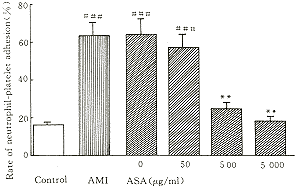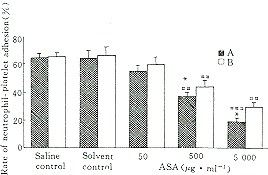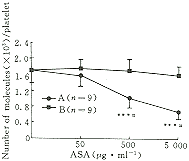阿司匹林抑制急性心肌梗死患者血小板与白细胞的粘附△
作者:高存记 于晓霞 林勇 汪钟
单位:中国医学科学院 中国协和医科大学 基础医学研究所药理室,北京 100005
关键词:阿司匹林;血小板;中性粒细胞;心肌梗死;颗粒膜蛋白-140
中国医学科学院学报990406
摘要 目的 研究阿司匹林(乙酰水杨酸,ASA)对急性心肌梗死(AMI)患者血小板与白细胞粘附的影响及其作用机制。方法 采用体外玫瑰花结形成实验检测血小板与白细胞粘附,观察ASA对两者粘附的作用;用125I标记的单克隆抗体测定血小板表面α颗粒膜蛋白-140(GMP-140)的表达,观察ASA对凝血酶诱导的血小板表面GMP-140表达的影响。结果 AMI患者血小板与白细胞间粘附率增高,凝血酶通过诱导血小板表面GMP-140的表达促进血小板与白细胞粘附;阿司匹林(500、5 000μg/ml)抑制AMI患者血小板与白细胞间的粘附,抑制凝血酶诱导的正常人血小板与白细胞间的粘附以及凝血酶诱导的血小板表面GMP-140的表达。结论 ASA一方面通过抑制GMP-140的表达,另一方面可能通过影响配体间的结合抑制血小板与白细胞之间的粘附,揭示了ASA抗栓作用的另外一种机制。
中图号 R973.2 R322.1+2 R558
Aspirin Inhibited the Adhesion of Platelets to Neutrophil in Patients
with Acute Myocardiac Infarction
with Acute Myocardiac Infarction
Gao Cunji Yu Xiaoxia Lin Yong Wang Zhong#
(Department of Pharmacology,Institute of Basic Medical Sciences,CAMS and PUMC,Beijing 100005)
Objective To investigate the effect and mechanism of aspirin(ASA) on platelet-neutrophil adhesion. Methods Using rosette forming assay to observe the effect of ASA on the binding of platelets to neutrophil and radioimmunoassay to observe the effect of ASA on the thrombin-induced expression of GMP-140 on the surface of human platelets. Results Patients with acute myocardial infarction showed a significant increase in neutrophil-platelet adhesion(63.3±7.8)%,(n=20,P<0.001)as compared with normal subjects(16.5±2.6)%(n=20).Thrombin promoted adhesion by increasing the expression of GMP-140 on the surface of human platelets.When the concentration of thrombin was 0.5 U/ml, the rate of neutrophil-platelet adhesion and the number of molecular of GMP-140 on the surface of platelet was (64.2±4.2)%,and (1.80±0.20)×103 per platelet respectively. At high concentration,ASA significantly inhibited thrombin (0.5 U/ml)stimulated platelets binding to neutrophils and expressing GMP-140 on their surface. When the final concentration of ASA was 500,5000 μg/ml,the ratio of thrombin-stimulated platelets binding neutrophils was (34.7±3.8)%,(21.2±3.6)% respectively (n=20,P<0.01); the number of molecular of GMP-140 expressing on the surface of platelet was (1.02±0.24)×103,(0.68±0.18)×103 per platelet respectively (n=9,P<0.001).Conclusions It contributes to the antithrombosis of ASA that inhibiting platelet-neutrophil adhesion by down expression of GMP-140 on the surface of human platelets.
Key words aspirin; platelet; neurophil; acute myocardial infarction; GMP-140
血栓形成是多细胞参与的复杂过程,也是导致急性心肌梗死(AMI)的直接原因。文献报道,不稳定的心绞痛患者或实验性AMI动物模型,都存在中性粒细胞(PMN)和血小板的激活以及两者间的粘附增加[1,2]。阿司匹林(ASA)作为一种抗血小板药,已广泛用于临床,除通过抑制血栓素A2合成而抑制血栓形成外,尚可通过抑制细胞间粘附及粘附分子的表达参与抗血栓形成的调节[3,4]。本研究采用玫瑰花结形成实验以及放射免疫方法观察AMI患者血小板与PMN粘附的改变,对阿司匹林参与调节PMN与血小板粘附的机制进行了初步探讨。
1 材料和方法
试剂 阿司匹林、右旋糖苷、凝血酶为Sigma公司产品,抗血小板表面α颗粒膜蛋白-140(GMP-140)单克隆抗体S12由美国Centocor公司馈赠。
标本 20例AMI住院患者外周血标本来自北京朝阳医院,分别于入院时(发病后1 h内)及入院治疗(抗凝、溶栓、抗血小板)24 h后于肘静脉采血。正常人血标本采自健康自愿者,采样前两周内未服用阿司匹林类药物。
ASA的配制 用无水乙醇配制成500 mg/ml的ASA溶液(pH2.7),并用乙醇作梯度稀释,密封后置-20℃冰箱备用。
血样采集及血小板、PMN的分离、洗涤及悬浮 肘静脉采血5 ml,按文献[2]方法分离、洗涤血小板、PMN。用PBS(pH7.0)悬浮血小板并将其调整至1×108个/ml;用Hank′s液悬浮PMN,将PMN数调至2×106个/ml,置4℃冰箱备用。
玫瑰花结形成实验 取50 μl AMI患者血小板悬液,加1 μl ASA乙醇溶液(浓度≤1%,此浓度的乙醇对实验结果无影响[2,5]),ASA终浓度分别为0、50、500、5 000 μg/ml,室温下孵育10 min,再加100 μl PMN悬液,按文献[5]方法计算玫瑰花结形成百分率。
ASA对凝血酶激活的血小板与PMN粘附的影响 取50 μl正常人血小板悬液,与凝血酶(终浓度为0.05、0.5、1、2 U/ml)于室温下孵育10 min,加100 μl PMN悬液,4℃放置30 min,取少量细胞于血球计数板上,同法计算玫瑰花结形成百分率。分两组观察ASA的影响,一组先用0.5 U/ml凝血酶刺激血小板5 min后,加入不同浓度的ASA(0、50、500、5 000μg/ml),另一组先用不同浓度的ASA与血小板孵育10 min,再加相同浓度凝血酶。
血小板膜表面GMP-140分子数测定 按文献[6]方法用125I标记的单克隆抗体S12、制备血小板悬液,调整血小板数至2.5×106个/ml。取血小板悬液100 μl,分别加入不同浓度的凝血酶(0.05、0.5、1、2 U/ml),作用5 min后,用0.1%戊二醛固定30 min,用血小板悬浮液洗涤1次后,再加0.5 ml悬浮液及0.1 ml 0.33 kBq125I-S12单克隆抗体,混匀,4℃过夜后洗涤2次,用γ计数仪测定沉淀中125I放射性活度,按下列公式计算每个血小板上的GMP-140分子数(结果以分子数/个血小板表示)。

分别观察不同浓度的ASA在凝血酶刺激血小板前、后,对血小板膜表面GMP-140表达的影响。
统计学处理 实验数据以均值±标准差表示,组间差异性比较采用t检验。
2 结果
AMI患者治疗前、后PMN与血小板粘附率的变化以及ASA的影响 AMI患者治疗前血小板与PMN的粘附率为(63.3±7.8)%,显著高于正常人的粘附率(16.5±2.6)%;经抗凝、溶栓及抗血小板药处理后,血小板与PMN的粘附率降至(28.7±5.6)% 。加入不同浓度ASA后,当浓度大于500 μg/ml时,AMI患者冶疗前的血小板与PMN的粘附率明显减低(图1)。

图 1 ASA对AMI患者治疗前的血小板与PMN粘附的影响
Fig 1 Effect of ASA on the platelet-neutrophil
adhesion of AMI (x±s,n=20) prior to treatment
**P<0.01vs AMI;### P<0.001 vs control
凝血酶对正常人血小板与PMN粘附的作用及ASA的影响 0.05、0.5、1、2 U/ml凝血酶明显促进血小板与PMN的粘附,呈剂量效应相关(r=0.89,P<0.02)(附表)。不论先加或后加500、5 000μg/ml ASA,均能显著抑制0.5 U/ml凝血酶诱导的血小板与PMN的粘附;但先加入ASA的抑制效应明显高于后加入者(图2)。

图 2 ASA对凝血酶刺激的正常人血小板与PMN粘附的影响
Fig 2 Effect of ASA on the adhesion of thrombin-stimulated platelets to neutrophil(x±s,n=20)
ASA was incubated with platelets before (A) and after (B) thrombin stimulation;*P<0.05 vs B in the same dose assay; ##P<0.01,###P<0.001 vs solvent control in the same group
ASA对凝血酶诱导的正常人血小板表面GMP-140表达的影响 静止血小板膜表面GMP-140分子数为(816±126)/个血小板,凝血酶刺激血小板膜表面GMP-140分子数的表达,且呈剂量效应相关(r=0.83,P<0.05)(附表)。先加入500、5 000 μg/ml ASA,显著降低凝血酶诱导的血小板表面GMP-140的表达;若凝血酶刺激后再加入ASA,则无影响(图3)。
附表 凝血酶对正常人血小板与PMN的粘附及血小板表面GMP-140表达的影响
Table Effect of thrombin on the adhesion of platelets to PMN and the expression of GMP-140 on the surface of platelets Final concentration of
thrombin(U/ml)
Rate of positive rosettes(%)
(n=20)
Number of molecule of
GMP-140(×103)/platelet
(n=9)
0
16.5±1.7
0.71±0.12
0.05
22.4±1.2*
1.38±0.16*
0.5
64.2±4.2**
1.80±0.20***
1
86.6±6.4***
2.00±0.11***
2
92.3±7.2***
2.27±0.23***
*P<0.05,**P<0.01,***P<0.001 compared with 0 group

图 3 ASA对凝血酶刺激的血小板表面GMP-140表达的影响
Fig 3 Effect of ASA on the expression of GMP-140 on the surface of thrombin-stimulated platelet
ASA was added before(A) or after(B) thrombin stimulation;#P<0.05 compared with group B;P<0.001 compared with solvent control
3 讨论
血栓形成是多细胞主动参与的复杂的病理生理过程,也是AMI发病的主要因素。本研究观察到AMI患者血小板与PMN粘附率明显增高,这与实验性AMI大鼠模型所得结果相似[2],再次证实AMI时血小板与PMN均被激活,而抗凝、抗血小板药如ASA能明显抑制AMI患者的血小板与PMN激活。本实验结果还表明,体外用凝血酶刺激正常血小板,血小板与PMN之间的粘附率也增加,同时伴随着血小板膜表面GMP-140分子数的增加,这与阮 健等[7]所观察到的结果相似,提示体外血小板与PMN之间的粘附至少部分由GMP-140介导。
文献报道,大剂量ASA(400~4 000 μg/ml)能抑制ADP、胶原诱导的血小板膜表面GMP-140的表达[8,9]。本实验也观察到500、5 000μg/ml ASA预先同血小板孵育,可降低0.5 U/ml凝血酶诱导的血小板表面GMP-140的表达,抑制血小板与PMN的粘附。Rinder 等[10]研究表明,血小板外环境的酸化可显著抑制其GMP-140的表达。ASA为一酸性物质,因此,除ASA的特异性作用外,高浓度的ASA所形成的血小板外酸性环境也可能是其抑制凝血酶诱导血小板GMP-140表达的原因之一。在凝血酶激活血小板后加入ASA,仅抑制血小板与PMN的粘附,对血小板表面GMP-140的表达无影响;这可能是由于凝血酶刺激血小板后,血小板已完成GMP-140的表达;因此在凝血酶刺激血小板后再加入ASA不影响血小板表面GMP-140的分子数,但ASA仍抑制凝血酶激活的血小板与PMN的粘附。推测高浓度的ASA所形成的血小板外酸性环境可能影响了GMP-140与其配体的结合。
文献报道AMI大鼠的血小板与PMN的粘附在结扎冠脉后30 min逐渐增加,16~24 h达高峰,48 h后略下降[2]。本研究结果显示,只有高浓度ASA (500、5 000 μg/ml)才能抑制AMI患者血小板与PMN的粘附。Mickelson等[11]用狗心肌缺血模型研究ASA的抗栓作用,发现仅高剂量的ASA(20 mg/kg)才能稳定左冠脉血流、延长血栓形成的时间、减少已形成血栓的体积,而低剂量(4.6 mg/kg)则无效。综合上述结果提示:在临床上AMI的早期(发病24 h内)若给予大剂量的ASA,则可能更有利于AMI的治疗和预后。当然,这尚需进行深入的动物和临床试验加以证实。
(致谢:朝阳医院内科监护室的琐志敏医师及全体护士在采集患者血样时给予了大量帮助)
参考文献
1 Ott I,Neumann FJ, Gawaz M, et al.Increased neutrophil-platelet adhesion in patients with unstable angina. Circulation,1996,94(6):1239~1246
2 林 勇,汪 钟.急性心肌梗塞大鼠血小板与白细胞的相互作用.基础医学与临床,1997,17(5):56~60
3 Pierce JW,Read MA,Ding H,et al.Salicylates inhibit I κ B phosphorylation,endothelial-leukocyte adhesion molecule expression, and neutrophil transmigration.J Immunol,1996,156:3961~3969
4 汪 钟,高存记.阿司匹林抗栓作用的研究进展.见金正均、王永铭、苏定冯主编.药理学进展.上海:科学出版社,1998.86~95
5 Hamburger SA,McEver RP.GMP-140 mediates adhesion of stimulated platelets to neutrophils.Blood, 1990,75(3):550~554
6 翁 进,朱雪静,林 勇,等.甘糖酯对血小板与内皮细胞功能的影响.中国医学科学院学报,1997,19(6):414~418
7 阮 健,赵相印,李清朗,等.血小板α颗粒膜蛋白-140在治疗急性心肌梗塞的动态监测.中华内科杂志,1995,34(4):253~255
8 Taylor ML,Misso NLA,Stewart GA,et al.The effects of varying doses of aspirin on human platelet activation induced by PAF, collagen and arachidonic acid.Br J Clin Pharmacol,1992,33:25~31
9 Taylor ML,Misso NLA,Stewart GA,et al.Differential expression of platelet activation markers in aspirin-sensitive asthmatics and normal subjects.Clin Exp allergy,1996,26202~26215
10 Rinder CS, Student LA,Bonan JL,et al.Aspirin does not inhibit adenosine-diphosphate-induced platelet granule release.Blood,1993,82:505~512
11 Mickelson JK,Hoff PT,Homeister JW,et al.High dose intravenous aspirin, not low dose intravenous or oral aspirin inhibits thrombus formation and stabilizes blood flow in experimental coronary vascular injury.J Am Coll Cardiol,1993,21:502~510
(1998-06-02收稿)

